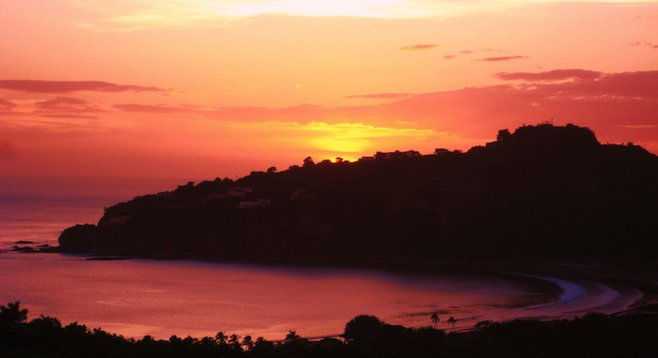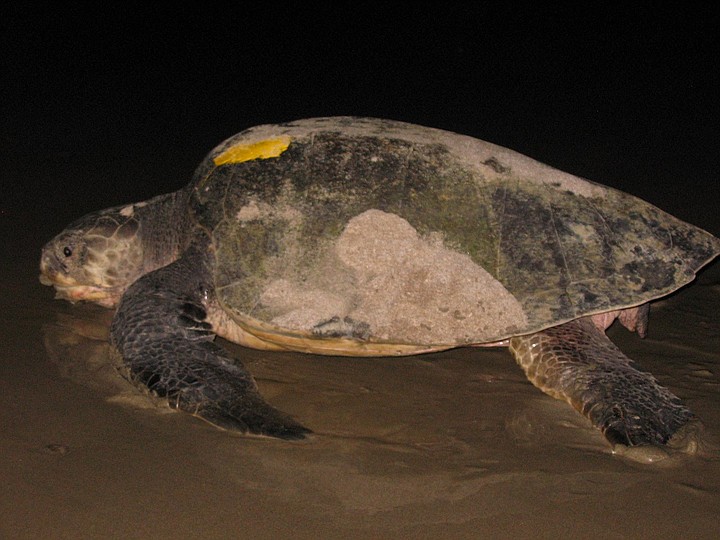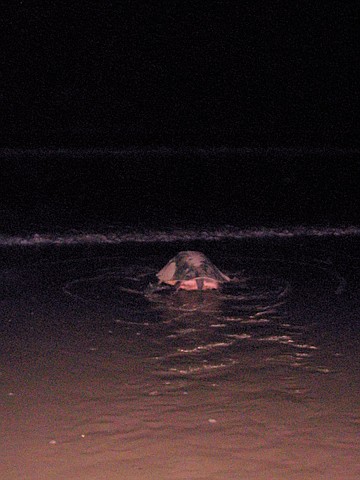 Facebook
Facebook
 X
X
 Instagram
Instagram
 TikTok
TikTok
 Youtube
Youtube

On our first night at Pelican Eyes Hotel, my mom penciled us in for a midnight adventure tour to see turtles nesting on a beach one hour north of San Juan del Sur (near Playa Maderas). We boarded a boat/bus with two benches placed back-to-back, with steel poles girding us from beside and above.
According to our guide, the national park north of Playa Maderas was one of seven of its kind in the world – beaches called arribadas where, on one crazy night, thousands of turtles nest, laying 140 eggs (give or take a dozen).
We walked closer to shore as dark, tear-shaped shadows emerged and took shape before us. The guide had an almost preternatural ability to determine, without light, where turtles were arriving to nest or returning to the water.

The first turtle we found dug a hole with rubbery, shovel-like fins, tossing dirt onto our feet and knees. She’d turn away from the hole, releasing around 140 eggs. We were only allowed to take pictures of their nests during the laying, when mama tortuga goes into a tantric-like trance state, unaffected by visual or auditory stimulus.
(Now I’m no guide, less a biologist, but I’ve heard from human mothers that this is a little different than human births). Once finished, she would toss more sand onto the hole and use her body weight to pack down the sand. The next morning a nest would look like any other patch of packed sand.
I’m amazed that the mother goes through the nesting, given she will never know if one of her eggs is successful. Only one in five hatch and only 2 percent of these reach maturity. On a 1.5-square-kilometer beach like the one we were at, only five or so babies will climb out of the nest, sandy-nosed, scuttle to the water, and swim to some kind of a freedom. Only one in a thousand shelled swimmers will be successful.
One of the turtles came to the beach covered in a bioluminescent slime that lit up when the guide touched her back: “You can see there’s lightning when I touch her.” Then we heard intermittent gunshots, and the guide quietly, and not without some saltiness, muttered, “Poachers.” Why the egg-hunters would kill the turtles, we could not understand. Today, the navy protects the beaches, and eggs taken from poachers have a better chance at surviving than they do in nature.

Another turtle came to the beach with a fish attached to her back. The guide maniacally got it into his mind to save the fish; however, the fish would not swim without accompaniment from his turtle. He decided that I, red flashlight in toe, would be his fish-saving assistant. The guide surmised (given the suction-like cavity on the bottom) that the fish was a parasite, an underwater hitchhiker; our job, then, was to find another turtle returning to the sea. We found this turtle, but the fish would not attach to her.
“I guess he love your turtle, man,” the guide told me. (The remaining twelve members of the group were on the shore watching hatchings). After patient waiting, the fish decided that the new turtle would be a suitable partner and set off for the deep, black unknown with her.
Sometimes letting go can seem as hard as death, I guess, unless you’re a mother turtle. For them, perhaps, nature strikes deeper than the heartstrings of motherhood. I don’t know.


On our first night at Pelican Eyes Hotel, my mom penciled us in for a midnight adventure tour to see turtles nesting on a beach one hour north of San Juan del Sur (near Playa Maderas). We boarded a boat/bus with two benches placed back-to-back, with steel poles girding us from beside and above.
According to our guide, the national park north of Playa Maderas was one of seven of its kind in the world – beaches called arribadas where, on one crazy night, thousands of turtles nest, laying 140 eggs (give or take a dozen).
We walked closer to shore as dark, tear-shaped shadows emerged and took shape before us. The guide had an almost preternatural ability to determine, without light, where turtles were arriving to nest or returning to the water.

The first turtle we found dug a hole with rubbery, shovel-like fins, tossing dirt onto our feet and knees. She’d turn away from the hole, releasing around 140 eggs. We were only allowed to take pictures of their nests during the laying, when mama tortuga goes into a tantric-like trance state, unaffected by visual or auditory stimulus.
(Now I’m no guide, less a biologist, but I’ve heard from human mothers that this is a little different than human births). Once finished, she would toss more sand onto the hole and use her body weight to pack down the sand. The next morning a nest would look like any other patch of packed sand.
I’m amazed that the mother goes through the nesting, given she will never know if one of her eggs is successful. Only one in five hatch and only 2 percent of these reach maturity. On a 1.5-square-kilometer beach like the one we were at, only five or so babies will climb out of the nest, sandy-nosed, scuttle to the water, and swim to some kind of a freedom. Only one in a thousand shelled swimmers will be successful.
One of the turtles came to the beach covered in a bioluminescent slime that lit up when the guide touched her back: “You can see there’s lightning when I touch her.” Then we heard intermittent gunshots, and the guide quietly, and not without some saltiness, muttered, “Poachers.” Why the egg-hunters would kill the turtles, we could not understand. Today, the navy protects the beaches, and eggs taken from poachers have a better chance at surviving than they do in nature.

Another turtle came to the beach with a fish attached to her back. The guide maniacally got it into his mind to save the fish; however, the fish would not swim without accompaniment from his turtle. He decided that I, red flashlight in toe, would be his fish-saving assistant. The guide surmised (given the suction-like cavity on the bottom) that the fish was a parasite, an underwater hitchhiker; our job, then, was to find another turtle returning to the sea. We found this turtle, but the fish would not attach to her.
“I guess he love your turtle, man,” the guide told me. (The remaining twelve members of the group were on the shore watching hatchings). After patient waiting, the fish decided that the new turtle would be a suitable partner and set off for the deep, black unknown with her.
Sometimes letting go can seem as hard as death, I guess, unless you’re a mother turtle. For them, perhaps, nature strikes deeper than the heartstrings of motherhood. I don’t know.
Comments